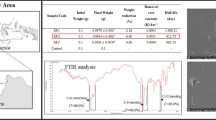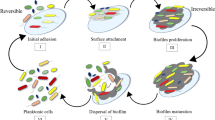Abstract
Biocalcification or microbially induced carbonate precipitation (MICP) is gaining attention from the research fraternity, primarily ascribed to their eco-friendly applications. Bacterial strains have been isolated from various sources and their ability to precipitate carbonate has been studied extensively. In spite of the fact that the deep-sea environment is a potential source for bioprospecting, meager reports exist on the isolation of biocalcifying bacterial strains from deep-sea. In this study, a deep-sea sediment sample obtained from off-Barren Island coast in the Andaman Sea was investigated for biocalcifying strains. Based on the urease activity and the ability to produce calcite crystals, the strain NIOTVJ5 was chosen for further investigations. The strain showed a similarity to Bacillus thuringiensis through 16S rRNA sequencing and was shown to possess positive urease, protease, amylase, catalase, and oxidase activities. The isolate was found to be piezotolerant as it was able to survive at 100 bar pressure with significant changes in the spore morphology. The strain was able to produce strong monoxenic biofilms as well. Maximum urease activity was 554.03 U/mL and it precipitated 1.80 g/L of carbonate crystals. Scanning electron microscopy coupled with energy dispersive X-ray spectroscopy confirmed the presence of calcium carbonate. The carbonate polymorph was identified as calcite using X-ray powder diffraction. The impact of biocalcification by NIOTVJ5 on concrete specimens indicated an increase of 30.91% in their compressive strength. This is the first report of a biocalcifying strain from a deep-sea sediment around the Indian subcontinent region. This study indicates the potential of the strain NIOTVJ5, which can be employed for various biotechnological applications.







Similar content being viewed by others
References
Abo-El-Enein SA, Ali AH, Talkhan FN, Abdel-Gawwad HA (2013) Application of microbial biocementation to improve the physico-mechanical properties of cement mortar. HBRC J 9:36–40
Achal V, Pan X (2014) Influence of calcium sources on microbially induced calcium carbonate precipitation by Bacillus sp. CR2. Appl Biochem Biotechnol 173:307–317
Achal V, Mukherjee A, Basu PC, Reddy MS (2009) Strain improvement of Sporosarcina pasteurii for enhanced urease and calcite production. J Ind Microbiol Biotechnol 36:981–988
Achal V, Pan X, Zhang D (2011) Remediation of copper-contaminated soil by Kocuria flava CR1, based on microbially induced calcite precipitation. Ecol Eng 37:1601–1605
Bartlett D, Wright M, Yayanos AA, Silverman M (1989) Isolation of a gene regulated by hydrostatic pressure in a deep-sea bacterium. Nature 342:572–574
Bazylinski DA, Frankel RB, Konhauser KO (2007) Modes of biomineralization of magnetite by microbes. Geomicrobiol J 24:465–475
Bell EM (2012) Life at extremes: environments, organisms and strategies for survival. CABI, Cambridge
Castanier S, Le Métayer-Levrel G, Perthuisot JP (1999) Ca-carbonates precipitation and limestone genesis—the microbiogeologist point of view. Sediment Geol 126:9–23
DeLong EG, Yayanos AA (1985) Adaption of the membrane lipids of a deep-sea bacterium to changes in hydrostatic pressure. Science 228:1101–1104
Dhami NK, Reddy MS, Mukherjee A (2013) Biomineralization of calcium carbonate polymorphs by the bacterial strains isolated from calcareous sites. J Microbiol Biotechnol 23:707–714
Dhami NK, Reddy MS, Mukherjee A (2014) Synergistic role of bacterial urease and carbonic anhydrase in carbonate mineralization. Appl Biochem Biotechnol 172:2552–2561
Djordjevic D, Wiedmann M, McLandsborough LA (2002) Microtiter plate assay for assessment of Listeria monocytogenes biofilm formation. Appl Environ Microbiol 68:2950–2958
Falkowski PG, Fenchel T, Delong EF (2008) The microbial engines that drive Earth’s biogeochemical cycles. Science 320:1034–1039
Ganendra G, De Muynck W, Ho A, Arvaniti EC, Hosseinkhani B, Ramos JA et al (2014) Formate oxidation-driven calcium carbonate precipitation by Methylocystis parvus OBBP. Appl Environ Microbiol 80:4659–4667
Gorospe CM, Han SH, Kim SG, Park JY, Kang CH, Jeong JH, So JS (2013) Effects of different calcium salts on calcium carbonate crystal formation by Sporosarcina pasteurii KCTC 3558. Biotechnol Bioprocess Eng 18:903–908
Hammes F, Verstraete W (2002) Key roles of pH and calcium metabolism in microbial carbonate precipitation. Rev Environ Sci Biotechnol 1:3–7
Jha BK, Pragash MG, Cletus J, Raman G, Sakthivel N (2009) Simultaneous phosphate solubilization potential and antifungal activity of new fluorescent pseudomonad strains, Pseudomonas aeruginosa, P. plecoglossicida, and P. mosselii. World J Microbiol Biotechnol 25:573–581
Jiang L, Xu H, Qiao H (2017) Biomediated precipitation of calcium carbonate in a slightly acidic hot spring, Yunnan Province. Acta Geol Sin 91:145–155
Kamalakkannan MK, Prakash K (2014) Experimental study on structural behaviour of bacterial concrete in framed structure. Int J Eng Res Technol 3(11):1013–1016
Kato C, Sato T, Horikoshi K (1995) Isolation and properties of barophilic and barotolerant bacteria from deep-sea mud samples. Biodivers Conserv 4:1–9
Kawaguchi T, Decho AW (2002) A laboratory investigation of cyanobacterial extracellular polymeric secretions (EPS) in influencing CaCO3 polymorphism. J Cryst Growth 240:230–235
Krishnapriya S, Babu DV, Prince Arulraj G (2015) Isolation and identification of bacteria to improve the strength of concrete. Microbiol Res 174:48–55
Kumar S, Stecher G, Tamura K (2016) MEGA7: molecular evolutionary genetics analysis version 7.0 for bigger datasets. Mol Biol Evol 33:1870–1874
Labrenz M, Druschel GK, Thomsen-Ebert T, Gilbert B, Welch SA, Kemner KM, Logan GA, Summons RE, de Stasio G, Bond PL, Lai B, Kelly SD, Banfield JF (2000) Formation of sphalerite (ZnS) deposits in natural biofilms of sulfate-reducing bacteria. Science 290:1744–1747
Li M, Cheng X, Guo H (2013) Heavy metal removal by biomineralization of urease producing bacteria isolated from soil. Int Biodeterior Biodegrad 76:81–85
Li W, Tang XX, Yan X, Wu Z, Yi ZW, Fang MJ, Su X, Qiu YK (2016) A new macrolactin antibiotic from deep sea-derived bacteria Bacillus subtilis B5. Nat Prod Res 30:2777–2782
Lian B, Hu Q, Chen J, Ji J, Teng HH (2006) Carbonate biomineralization induced by soil bacterium Bacillus megaterium. Geochim Cosmochim Acta 70:5522–5535
Mann S (1995) Biomineralization and biomimetic materials chemistry. J Mater Chem 5:935–946
Mitchell AC, Ferris FG (2005) The coprecipitation of Sr into calcite precipitates induced by bacterial ureolysis in artificial groundwater: temperature and kinetic dependence. Geochim Cosmochim Acta 69:4199–4210
Mitchell AC, Dideriksen K, Spangler LH, Cunningham AB, Gerlach R (2010) Microbially enhanced carbon capture and storage by mineral-trapping and solubility-trapping. Environ Sci Technol 44:5270–5276
Natarajan KR (1995) Kinetic study of the enzyme urease from Dolichos biflorus. J Chem Educ 72:556
Novitsky JA (1981) Calcium carbonate precipitation by marine bacteria. Geomicrobiol J 2:375–388
Ohta Y, Hatada Y (2006) A novel enzyme, λ-carrageenase, isolated from a deep-sea bacterium. J Biochem 140:475–481
Park SJ, Chun WY, Kim WJ, Ghim SY (2012) Application of alkaliphilic biofilm-forming bacteria to improve compressive strength of cement-sand mortar. J Microbiol Biotechnol 22:385–389
Ramakrishnan V, Bang SS, Deo KS (1998) A novel technique for repairing cracks in high performance concrete using bacteria. In: proceeding of the international conference on high performance. High strength. Concrete 597–617
Rivadeneyra MA, Delgado R, Delgado G, Moral AD, Ferrer MR, Ramos-Cormenzana A (1993) Precipitation of carbonates by Bacillus sp. isolated from saline soils. Geomicrobiol J 11:175–184
Rivadeneyra MA, Delgado G, Ramos-Cormenzana A, Delgado R (1998) Biomineralization of carbonates by Halomonas eurihalina in solid and liquid media with different salinities: crystal formation sequence. Res Microbiol 149:277–287
Sánchez-Román M, Rivadeneyra MA, Vasconcelos C, McKenzie JA (2007) Biomineralization of carbonate and phosphate by moderately halophilic bacteria. FEMS Microbiol Ecol 61:273–284
Saravanan N, Pankaj Verma LV, Sendhil Kumar R, Somasundaram ST, Dharani G, Kirubagaran R (2014) Role of microbial aggregation in biofilm formation by bacterial strains isolated from offshore finfish culture environment. Indian J Geo-Marine Sci 43:2118–2129
Sarda D, Choonia HS, Sarode DD, Lele SS (2009) Biocalcification by Bacillus pasteurii urease: a novel application. J Ind Microbiol Biotechnol 36:1111–1115
Sharma TK, Alazhari M, Heath A, Paine K, Cooper RM (2017) Alkaliphilic Bacillus species show potential application in concrete crack repair by virtue of rapid spore production and germination then extracellular calcite formation. J Appl Microbiol 122:1233–1244
Stabnikov V, Jian C, Ivanov V, Li Y (2013) Halotolerant, alkaliphilic urease-producing bacteria from different climate zones and their application for biocementation of sand. World J Microbiol Biotechnol 29:1453–1460
Stocks-Fischer S, Galinat JK, Bang SS (1999) Microbiological precipitation of CaCO3. Soil Biol Biochem 31:1563–1571
Thompson JB, Ferris FG (1990) Cyanobacterial precipitation of gypsum, calcite, and magnesite from natural alkaline lake water. Geology 18:995–998
Thompson JD, Gibson T, Higgins DG (2002) Multiple sequence alignment using ClustalW and ClustalX. Curr Protoc Bioinformatics 1:2–3
Wei S, Cui H, Jiang Z, Liu H, He H, Fang N (2015) Biomineralization processes of calcite induced by bacteria isolated from marine sediments. Braz J Microbiol 46:455–464
Zamarreno DV, Inkpen R, May E (2009) Carbonate crystals precipitated by freshwater bacteria and their use as a limestone consolidant. Appl Environ Microbiol 75:5981–5990
Acknowledgments
The authors are thankful to Dr. R. Kirubagaran, Head, Marine Biotechnology Division, National Institute of Ocean Technology for providing his consent to carry out this work at NIOT. The authors would like to thank Dr. G. Dharani, Marine Biotechnology Division, National Institute of Ocean Technology for his constant suggestions on this work. The authors extend their thanks to Dr. Dilip Kumar Jha, Project Scientist-I, Marine Biotechnology Division, National Institute of Ocean Technology for sampling sitemap preparation. The authors would like to thank Dr. K. Balasubramaniam, Mr. K. Anbazhagan, and Mr. Aravindh, HiTech concrete solutions, Chennai, for their immense help in carrying out the experiments on concrete materials.
Author information
Authors and Affiliations
Corresponding author
Ethics declarations
Conflict of Interest
The authors declare that they have no competing interests.
Rights and permissions
About this article
Cite this article
Rangamaran, V.R., Shanmugam, V.K. Biocalcification by Piezotolerant Bacillus sp. NIOTVJ5 Isolated from Deep Sea Sediment and its Influence on the Strength of Concrete Specimens. Mar Biotechnol 21, 161–170 (2019). https://doi.org/10.1007/s10126-018-9867-8
Received:
Accepted:
Published:
Issue Date:
DOI: https://doi.org/10.1007/s10126-018-9867-8




